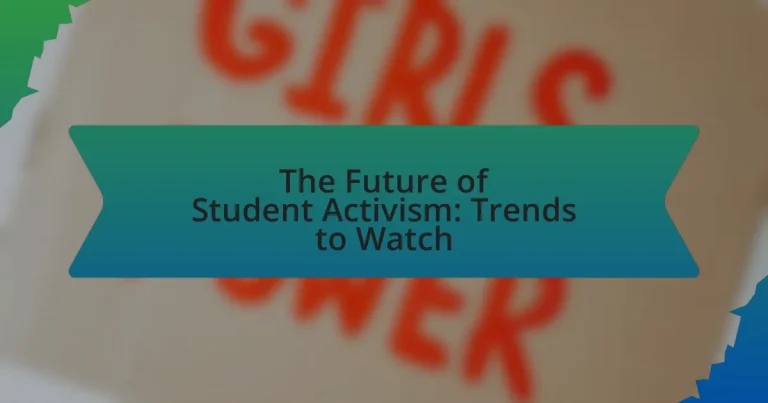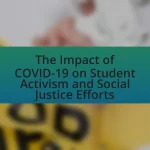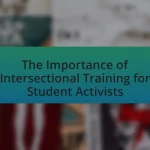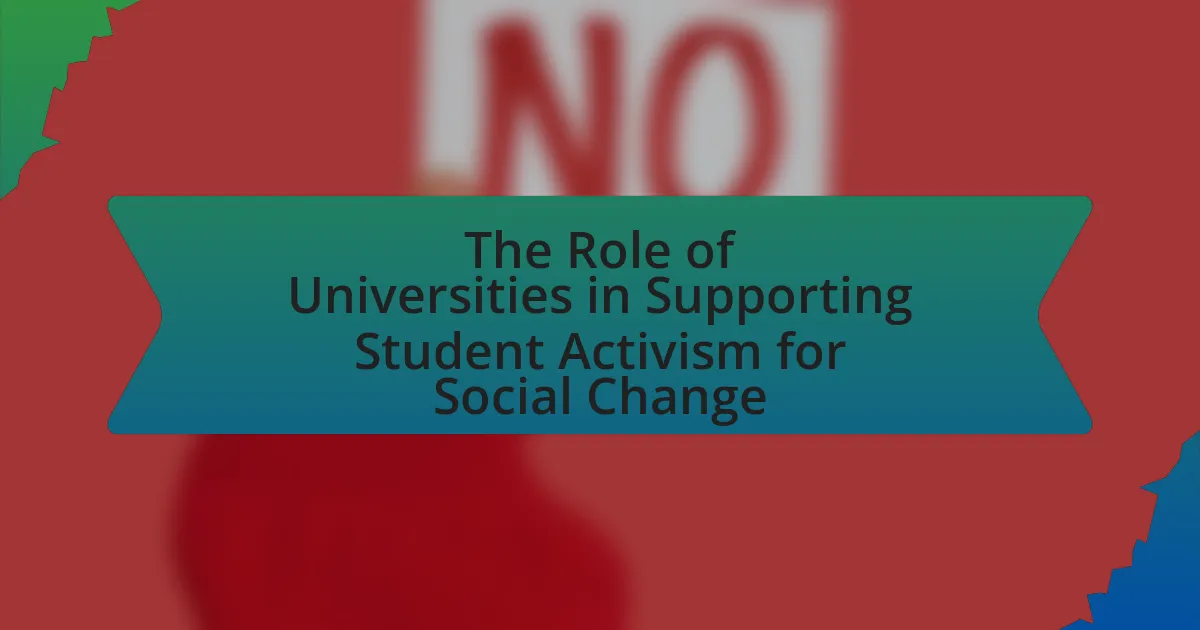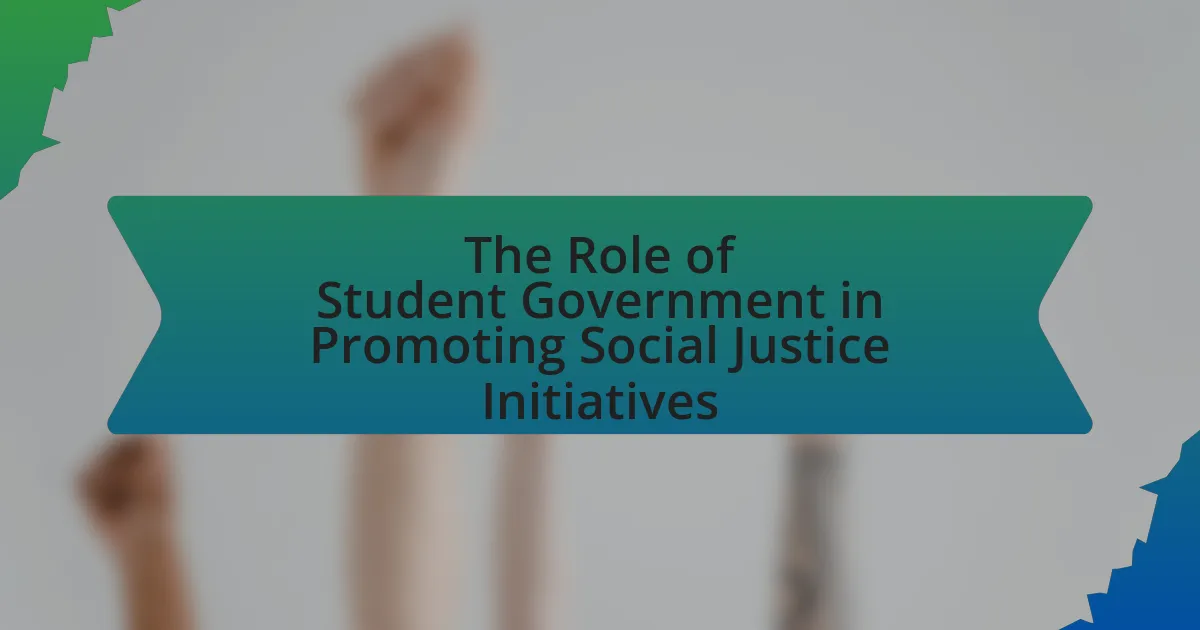The article examines the future of student activism, highlighting key trends such as increased digital engagement, intersectionality, and the influence of social media. It discusses how technological advancements facilitate communication and mobilization, enabling students to advocate for issues like climate change, racial justice, and mental health awareness. The piece also addresses the challenges student activists face, including institutional resistance and resource limitations, while emphasizing the importance of collaboration and effective communication strategies in driving social change. Overall, it provides insights into the evolving landscape of student activism and its implications for society and educational policies.
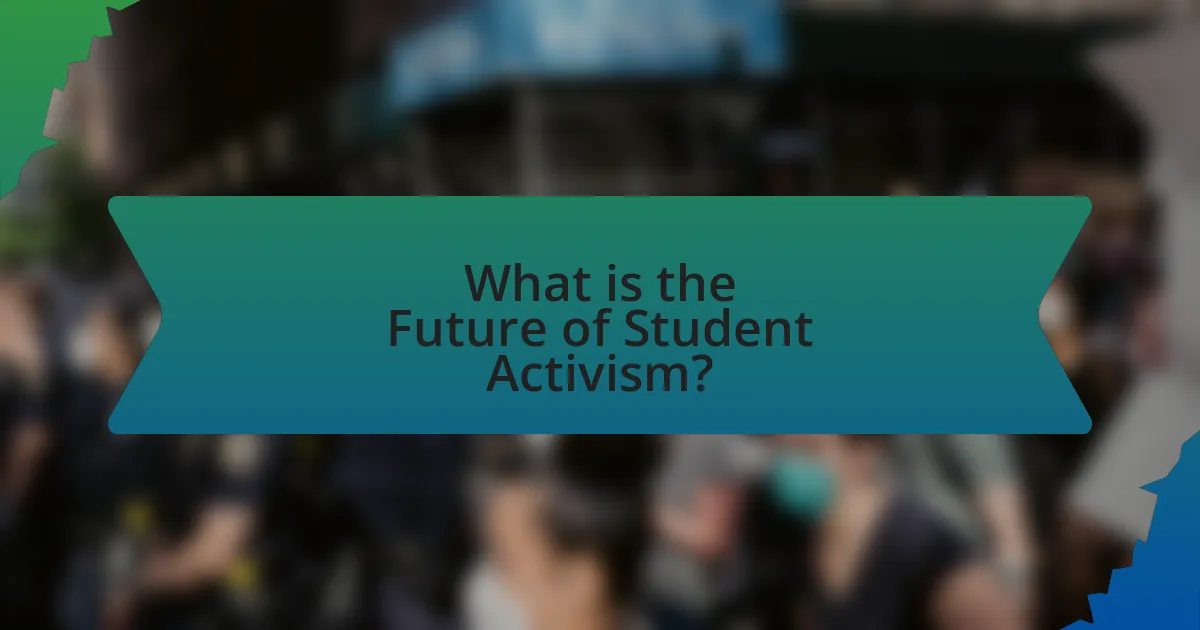
What is the Future of Student Activism?
The future of student activism is likely to be characterized by increased digital engagement and intersectionality. As technology continues to evolve, students will leverage social media platforms and online organizing tools to mobilize and advocate for social change more effectively. For instance, the rise of movements like Black Lives Matter and climate activism has shown how digital platforms can amplify voices and connect diverse groups. Additionally, the focus on intersectionality will drive students to address multiple social justice issues simultaneously, recognizing the interconnectedness of race, gender, and economic inequality. This trend is supported by research from the Pew Research Center, which indicates that 72% of young adults believe social media is an effective tool for activism.
How is student activism evolving in the current landscape?
Student activism is evolving through increased digital engagement and intersectionality, reflecting broader societal issues. The rise of social media platforms has enabled students to mobilize quickly, share information, and amplify their voices on issues such as climate change, racial justice, and mental health. For instance, the global climate strikes initiated by students in 2019, inspired by Greta Thunberg, showcased how digital tools can facilitate large-scale participation and awareness. Additionally, contemporary student movements are increasingly addressing intersectional concerns, recognizing how various identities impact experiences of oppression. This evolution is evidenced by the collaboration among diverse student groups advocating for comprehensive reforms, such as the Black Lives Matter movement’s influence on campus policies.
What factors are driving changes in student activism?
Changes in student activism are primarily driven by social media, increased awareness of global issues, and a shift in generational values. Social media platforms enable rapid information dissemination and mobilization, allowing students to organize and advocate for causes more effectively than in previous decades. Increased awareness of global issues, such as climate change and social justice, has led to a more interconnected understanding of activism, prompting students to engage in movements that transcend local boundaries. Additionally, a shift in generational values towards inclusivity and equity has influenced students to prioritize diverse voices and intersectionality in their activism efforts. These factors collectively reshape the landscape of student activism, making it more dynamic and responsive to contemporary challenges.
How do technological advancements influence student activism?
Technological advancements significantly enhance student activism by facilitating communication, organization, and mobilization. Digital platforms, such as social media, allow students to share information rapidly, coordinate events, and amplify their voices on a global scale. For instance, the use of Twitter during the Arab Spring in 2011 demonstrated how students and activists could organize protests and disseminate information quickly, leading to widespread awareness and participation. Additionally, tools like online petitions and crowdfunding platforms enable students to gather support and resources efficiently, further strengthening their initiatives. These advancements create a more interconnected and informed student body, ultimately driving more impactful activism.
Why is understanding the future of student activism important?
Understanding the future of student activism is important because it shapes the landscape of social change and influences policy decisions. As students increasingly engage in activism, their collective voice can drive significant societal shifts, as evidenced by movements like the March for Our Lives and climate strikes led by youth. These movements demonstrate that student activism can effectively mobilize public opinion and prompt legislative action, highlighting the necessity for stakeholders to recognize and support emerging trends in student-led initiatives.
What implications does student activism have on society?
Student activism significantly influences societal change by mobilizing youth around critical issues such as climate change, racial equality, and education reform. This mobilization often leads to increased public awareness and policy changes, as seen in movements like the March for Our Lives, which advocated for gun control following school shootings. Research indicates that student-led initiatives can result in tangible legislative outcomes; for example, the activism surrounding the Black Lives Matter movement has prompted discussions on police reform and systemic racism in various communities. Thus, student activism serves as a catalyst for social progress and policy reform, demonstrating the power of youth voices in shaping societal norms and legislation.
How can student activism shape educational policies?
Student activism can shape educational policies by mobilizing collective student voices to advocate for specific changes, influencing decision-makers through organized campaigns and demonstrations. For instance, the 2018 March for Our Lives movement, initiated by students in response to gun violence, successfully prompted discussions on gun control policies in schools and led to legislative proposals in various states. This demonstrates that when students unite around a cause, they can effectively impact policy discussions and outcomes, as evidenced by increased attention to mental health resources and safety measures in educational institutions following such activism.
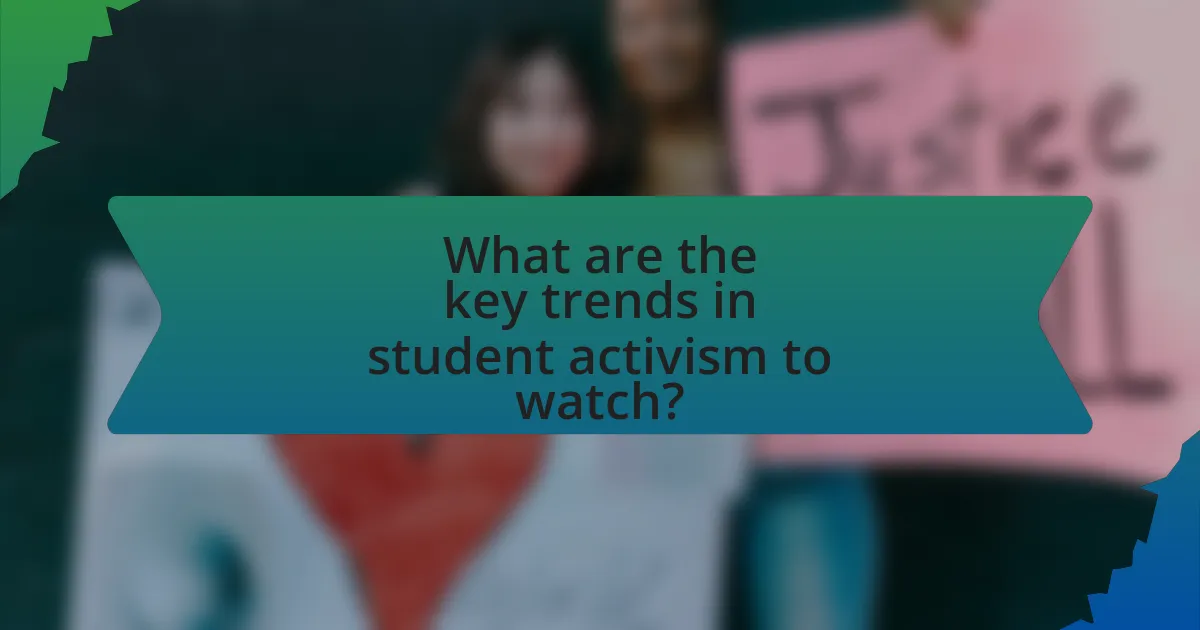
What are the key trends in student activism to watch?
Key trends in student activism include a focus on climate justice, mental health awareness, and racial equity. Climate justice has gained momentum as students mobilize for sustainable policies, evidenced by global movements like Fridays for Future, initiated by Greta Thunberg, which has seen millions of students participate in climate strikes. Mental health awareness is increasingly prioritized, with students advocating for better mental health resources on campuses, reflecting a broader societal recognition of mental health issues. Racial equity remains a critical issue, with students organizing around movements such as Black Lives Matter, demanding systemic changes in educational institutions and society at large. These trends indicate a shift towards intersectional activism, where students address multiple social justice issues simultaneously, reflecting a more holistic approach to advocacy.
How are social media platforms impacting student activism?
Social media platforms significantly enhance student activism by providing a space for rapid communication, organization, and mobilization. These platforms allow students to share information, coordinate events, and amplify their voices on social issues, leading to increased visibility and engagement. For instance, the #BlackLivesMatter movement gained momentum through social media, with students using platforms like Twitter and Instagram to organize protests and share resources. Research indicates that 79% of young activists believe social media is crucial for raising awareness and fostering community support, demonstrating its vital role in contemporary student activism.
What role do online campaigns play in mobilizing students?
Online campaigns play a crucial role in mobilizing students by providing a platform for information dissemination, community building, and collective action. These campaigns leverage social media and digital tools to engage students, allowing them to organize events, share resources, and amplify their voices on issues that matter to them. For instance, the #NeverAgain movement, which emerged after the Parkland shooting in 2018, successfully mobilized thousands of students across the United States to advocate for gun control, demonstrating the effectiveness of online campaigns in fostering student activism.
How do social media trends reflect broader societal issues?
Social media trends reflect broader societal issues by serving as a platform for collective expression and mobilization around key topics such as social justice, climate change, and political movements. For instance, the #BlackLivesMatter movement gained significant traction on platforms like Twitter and Instagram, highlighting systemic racism and police brutality, which are critical societal concerns. Research by the Pew Research Center indicates that 69% of U.S. adults believe social media is an important tool for activism, demonstrating its role in shaping public discourse and influencing societal change. Additionally, trends such as the viral spread of climate activism, exemplified by the Fridays for Future movement initiated by Greta Thunberg, illustrate how social media can amplify youth voices and concerns about environmental issues, reflecting a growing societal awareness and urgency around climate change.
What are the emerging issues that students are rallying around?
Students are increasingly rallying around issues such as climate change, racial justice, mental health awareness, and educational equity. For instance, the global climate strikes led by youth activists like Greta Thunberg have mobilized millions of students to advocate for urgent climate action. Additionally, movements addressing systemic racism, such as Black Lives Matter, have seen significant student participation, highlighting demands for policy changes and inclusivity on campuses. Mental health awareness has also gained traction, with students advocating for better mental health resources and support systems within educational institutions. Furthermore, educational equity has become a focal point, as students push for reforms that address disparities in access to quality education and resources. These issues reflect a broader trend of student activism that is increasingly intersectional and focused on social justice.
How is climate change influencing student activism?
Climate change is significantly influencing student activism by mobilizing young people to advocate for environmental justice and policy changes. This mobilization is evidenced by large-scale movements such as Fridays for Future, initiated by Greta Thunberg, which has inspired millions of students globally to participate in climate strikes and demand action from governments. Research indicates that 75% of young people believe climate change is a crisis, prompting them to engage in activism to address the urgent need for sustainable practices and policies. This trend reflects a growing awareness among students of the direct impact of climate change on their futures, leading to increased participation in protests, social media campaigns, and community initiatives aimed at combating environmental degradation.
What role does racial and social justice play in current movements?
Racial and social justice serve as foundational principles in current movements, driving activism and shaping agendas. These movements, such as Black Lives Matter and climate justice initiatives, emphasize the need for equitable treatment and systemic change to address historical injustices and ongoing discrimination. For instance, the 2020 protests following George Floyd’s death highlighted the intersection of racial inequality and police violence, mobilizing diverse groups to advocate for comprehensive reforms. This demonstrates that racial and social justice are not only central themes but also catalysts for collective action and policy change in contemporary activism.
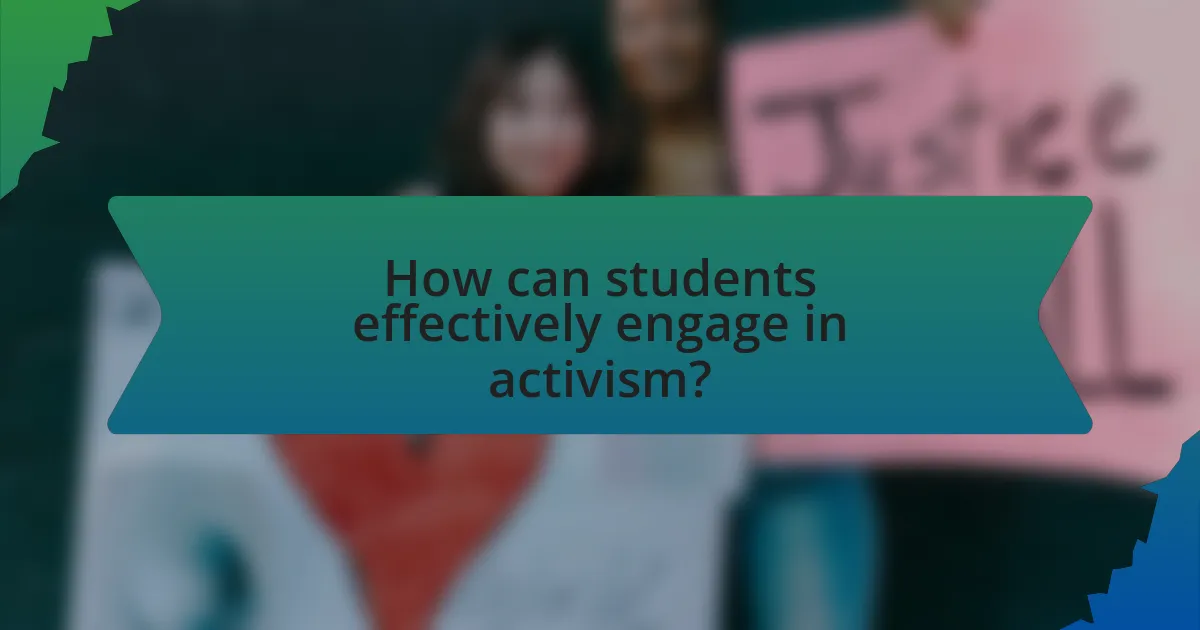
How can students effectively engage in activism?
Students can effectively engage in activism by organizing campaigns that address specific social issues, utilizing social media platforms for outreach, and collaborating with local organizations. Research indicates that student-led movements, such as the March for Our Lives, have successfully mobilized thousands by leveraging digital tools to raise awareness and foster community involvement. Additionally, studies show that students who participate in structured activism programs report increased civic engagement and leadership skills, highlighting the effectiveness of organized efforts in driving social change.
What strategies can students use to organize successful movements?
Students can organize successful movements by employing strategies such as building a strong coalition, utilizing social media for outreach, and creating clear goals. Building a coalition involves uniting diverse groups to amplify voices and resources, which has been shown to increase participation and impact, as seen in movements like the March for Our Lives. Utilizing social media allows for rapid dissemination of information and mobilization of supporters, evidenced by the viral nature of campaigns like #MeToo. Establishing clear, actionable goals helps maintain focus and direction, which is critical for sustaining momentum, as demonstrated in the successful organization of climate strikes led by youth activists.
How can collaboration with local communities enhance activism efforts?
Collaboration with local communities enhances activism efforts by fostering trust, increasing resource access, and amplifying voices. When activists engage with community members, they build relationships that lead to shared goals and mutual support, which is crucial for effective mobilization. For instance, studies show that grassroots movements that involve local stakeholders are more likely to succeed in achieving policy changes, as seen in the 2018 youth-led climate strikes, where local community support significantly bolstered participation and visibility. This collaboration not only strengthens the activism’s impact but also ensures that the initiatives are relevant and tailored to the community’s specific needs.
What are the best practices for effective communication in activism?
Effective communication in activism involves clarity, consistency, and engagement. Activists should articulate their message clearly to ensure it resonates with their audience, using straightforward language and avoiding jargon. Consistency in messaging across various platforms reinforces the cause and builds trust among supporters. Engaging storytelling can also enhance emotional connection, making the message more relatable and impactful. Research indicates that campaigns utilizing personal narratives can increase public support by up to 30%, demonstrating the power of effective communication strategies in activism.
What resources are available for student activists?
Student activists have access to various resources, including online platforms, community organizations, and educational institutions. Online platforms such as social media and dedicated activist websites provide tools for organizing, mobilizing, and sharing information. Community organizations often offer training, mentorship, and funding opportunities to support activism efforts. Educational institutions may provide resources like workshops, grants, and access to faculty expertise to enhance student-led initiatives. These resources collectively empower student activists to effectively advocate for their causes and engage their peers.
How can students access funding for their initiatives?
Students can access funding for their initiatives through various sources such as university grants, crowdfunding platforms, and sponsorship from local businesses. Universities often have dedicated funds or grants specifically for student-led projects, which can be applied for through their student affairs or student government offices. Crowdfunding platforms like GoFundMe or Kickstarter allow students to present their initiatives to a broader audience and raise funds directly from supporters. Additionally, local businesses may offer sponsorships or partnerships, providing financial support in exchange for advertising or community engagement opportunities. These funding avenues are essential for enabling students to implement their initiatives effectively.
What organizations support student activism and how can they help?
Organizations that support student activism include the Student Government Association (SGA), the American Civil Liberties Union (ACLU), and the National Student Association (NSA). These organizations help by providing resources, training, and advocacy for student-led initiatives. For instance, the SGA often facilitates funding and organizational support for student projects, while the ACLU offers legal assistance and educational materials on civil rights issues. The NSA connects students across campuses to share strategies and amplify their voices on national issues, thereby enhancing the impact of student activism.
What are the potential challenges facing student activists?
Student activists face several potential challenges, including institutional resistance, lack of resources, and social media backlash. Institutional resistance often manifests as administrative pushback against protests or initiatives, limiting the effectiveness of student-led movements. Additionally, many student activists struggle with inadequate funding and support, which can hinder their ability to organize events or campaigns. Social media backlash presents another significant challenge, as online criticism or harassment can discourage participation and create a hostile environment for activists. These challenges can impede the progress and impact of student activism, making it essential for activists to navigate these obstacles strategically.
How can students navigate institutional resistance?
Students can navigate institutional resistance by building coalitions and leveraging collective power. By uniting with diverse groups, students can amplify their voices and create a stronger front against institutional barriers. Research indicates that collective action, such as organizing protests or campaigns, has historically led to significant policy changes in educational institutions, as seen in the civil rights movements of the 1960s. Additionally, students can utilize social media platforms to raise awareness and mobilize support, effectively bypassing traditional institutional channels that may resist change. This approach not only fosters solidarity but also increases visibility and pressure on institutions to respond to student demands.
What legal considerations should student activists be aware of?
Student activists should be aware of their rights to free speech and assembly, as well as the potential legal repercussions of their actions. The First Amendment of the U.S. Constitution protects these rights, allowing students to express their views and organize protests on public school grounds. However, they must also consider school policies, local laws, and potential consequences such as disciplinary actions or arrests. For instance, the Tinker v. Des Moines Independent Community School District case established that students do not “shed their constitutional rights to freedom of speech or expression at the schoolhouse gate,” but this right is not absolute and can be limited if it disrupts the educational process. Understanding these legal frameworks is crucial for student activists to navigate their activism effectively and responsibly.
What practical tips can enhance student activism efforts?
To enhance student activism efforts, students should focus on building coalitions with diverse groups to amplify their voices and increase impact. Collaborating with various organizations allows for a broader reach and shared resources, which can lead to more effective campaigns. For instance, the 2018 March for Our Lives movement successfully united students, parents, and advocacy groups to address gun violence, demonstrating the power of collective action. Additionally, utilizing social media strategically can help in mobilizing support and spreading awareness quickly, as seen in the global response to climate change led by youth activists. Engaging in local community issues also strengthens activism by creating tangible connections and fostering support from the surrounding population.
